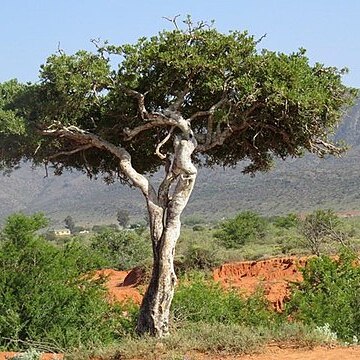Tree or shrub up to 4 m high. Branches ridged when young, glabrous, yellowish. Leaves alternate, not fascicled; lamina oblanceolate to elliptic, pointed or emarginate, mucronate, cuneate at the base, 2.5-6 cm long, 0.6-1(-1.5) cm broad, glabrous, yellowish-green, slightly shiny; petiole grooved above, 0.3-0.5 cm long, glabrous. Sclereids in the mesophyll differentiated into foot and stalk, often much bent with branchlets, usually pointed not branched at the apex, often reaching into the centre of the leaf, single, evenly developed on both sides of the leaf. Inflorescence terminal, rarely axillary, one to several racemes; peduncle 2-3 cm long, glabrous; pedicel 0.5-0.8 cm long, glabrous. Bracts lanceolate usually 3-partite, 1-2 mm long, glabrous except for a ciliate margin. Sepals obovate-elliptic, 2-3 mm long, glabrous with hairs on the margin. Petals 2-4, spathulate, 2-4 mm long, slightly fleshy, inserted on the corona, caducous. Corona a fleshy ring, denticulate. Stamens 4-6; filaments glabrous, 3-5 mm long. Gynophore 1-2 mm long, glabrous. Ovary elongate-ovoid, with 12 ovules; style 0.5 mm or less with indistinct stigma. Berry spherical, 0.4-1 cm in diameter, glabrous, with 1 or 2 seeds.
More
A shrub or tree. The flowers help distinguish this species from Boscia albitrunca. The leaves are hard and leathery. They are oblong and 2.5-5 cm long. They tend to be yellow-green. They have an easy to see midrib and are on short stalks. The leaves have small knobs near the base. The leaves are usually one after another along the branch. The flowers are small and star shaped. They have 2-4 petals. The flowers are usually at the ends of branches. They are yellow and have a strong sweet smell. The fruit is a smooth round berry. It can be 1.3 cm across.
Tree, 2-4 m high, branches ridged when young, yellowish, glabrous. Leaves alternate, yellowish green, glabrous, slightly shiny, oblanceolate to elliptic, pointed or emarginate, mucronate, cuneate at base; petioles grooved above, glabrous. Inflorescence terminal racemes. Bracts lanceolate, usually 3-partite. Sepals obovate-elliptic, glabrous with hairs on margins. Petals 2-4, spathulate, slightly fleshy, caducous. Stamens 4-6. Ovary elongate-ovoid, 12 ovules. Flowering time June-Nov. Fruit a spherical berry, glabrous. Seeds usually 1 or 2.


